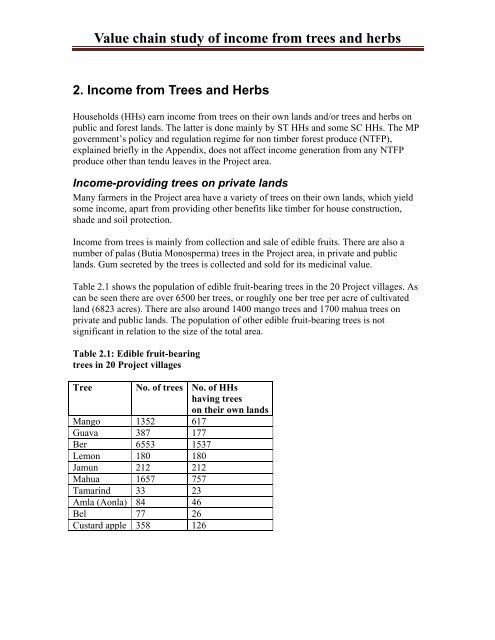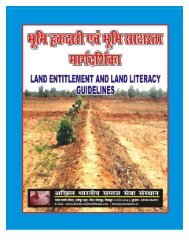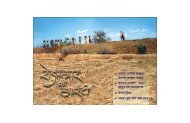Value chain study of income from trees and herbs - ABSSS
Value chain study of income from trees and herbs - ABSSS
Value chain study of income from trees and herbs - ABSSS
You also want an ePaper? Increase the reach of your titles
YUMPU automatically turns print PDFs into web optimized ePapers that Google loves.
<strong>Value</strong> <strong>chain</strong> <strong>study</strong> <strong>of</strong> <strong>income</strong> <strong>from</strong> <strong>trees</strong> <strong>and</strong> <strong>herbs</strong><br />
2. Income <strong>from</strong> Trees <strong>and</strong> Herbs<br />
Households (HHs) earn <strong>income</strong> <strong>from</strong> <strong>trees</strong> on their own l<strong>and</strong>s <strong>and</strong>/or <strong>trees</strong> <strong>and</strong> <strong>herbs</strong> on<br />
public <strong>and</strong> forest l<strong>and</strong>s. The latter is done mainly by ST HHs <strong>and</strong> some SC HHs. The MP<br />
government’s policy <strong>and</strong> regulation regime for non timber forest produce (NTFP),<br />
explained briefly in the Appendix, does not affect <strong>income</strong> generation <strong>from</strong> any NTFP<br />
produce other than tendu leaves in the Project area.<br />
Income-providing <strong>trees</strong> on private l<strong>and</strong>s<br />
Many farmers in the Project area have a variety <strong>of</strong> <strong>trees</strong> on their own l<strong>and</strong>s, which yield<br />
some <strong>income</strong>, apart <strong>from</strong> providing other benefits like timber for house construction,<br />
shade <strong>and</strong> soil protection.<br />
Income <strong>from</strong> <strong>trees</strong> is mainly <strong>from</strong> collection <strong>and</strong> sale <strong>of</strong> edible fruits. There are also a<br />
number <strong>of</strong> palas (Butia Monosperma) <strong>trees</strong> in the Project area, in private <strong>and</strong> public<br />
l<strong>and</strong>s. Gum secreted by the <strong>trees</strong> is collected <strong>and</strong> sold for its medicinal value.<br />
Table 2.1 shows the population <strong>of</strong> edible fruit-bearing <strong>trees</strong> in the 20 Project villages. As<br />
can be seen there are over 6500 ber <strong>trees</strong>, or roughly one ber tree per acre <strong>of</strong> cultivated<br />
l<strong>and</strong> (6823 acres). There are also around 1400 mango <strong>trees</strong> <strong>and</strong> 1700 mahua <strong>trees</strong> on<br />
private <strong>and</strong> public l<strong>and</strong>s. The population <strong>of</strong> other edible fruit-bearing <strong>trees</strong> is not<br />
significant in relation to the size <strong>of</strong> the total area.<br />
Table 2.1: Edible fruit-bearing<br />
<strong>trees</strong> in 20 Project villages<br />
Tree No. <strong>of</strong> <strong>trees</strong> No. <strong>of</strong> HHs<br />
having <strong>trees</strong><br />
on their own l<strong>and</strong>s<br />
Mango 1352 617<br />
Guava 387 177<br />
Ber 6553 1537<br />
Lemon 180 180<br />
Jamun 212 212<br />
Mahua 1657 757<br />
Tamarind 33 23<br />
Amla (Aonla) 84 46<br />
Bel 77 26<br />
Custard apple 358 126






